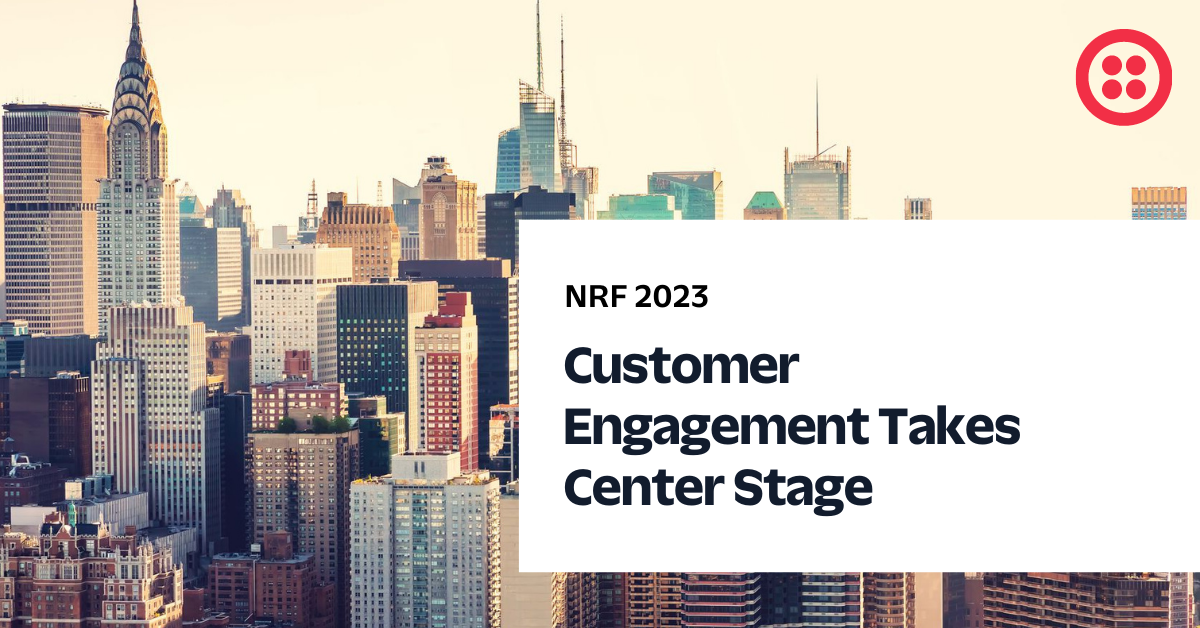NRF 2023: Customer Engagement Takes Center Stage
Time to read:
This post is part of Twilio’s archive and may contain outdated information. We’re always building something new, so be sure to check out our latest posts for the most up-to-date insights.

Are you ready?
It’s no secret that the face of the retail industry has changed in recent years. In 2022 alone, we saw massive shifts across the retail landscape with consumer preferences evolving from ecommerce dependence to 86% shopping both in-store and online. Retail stores have now fully opened back up, and with that, ecommerce growth came back down to earth.
Not to mention inflation set in, inventory stockpiled, and return rates were on the rise.
But while many of these market conditions are temporary (and will eventually work out), the era of unbridled demand spikes across digital channels has come to an end. A new set of retail realities has taken hold, forcing retailers to reexamine customer relationships.
So how can retailers fulfill the brand promise to customers in the face of changing consumer preferences and expectations?
To find out the answer, stop by the Twilio NRF booth #3957 (and keep reading)!
3 new retail realities
A retailer’s brand promise is the expectations a brand sets and must meet for customers. But in the face of evolving consumer behavior, retailers must now navigate 3 new retail realities to fulfill this brand promise:
- Customer shopping journeys are fluid: In 2023 and beyond, anticipate each shopper's journey to be unique and changing in real time. This means retailers must be nimble enough to meet the customer where they are in that journey and personalize every aspect of the shopping experience based upon preferences gathered through first-party data freely shared by loyal customers.
- Experimentation is a must: To get ahead of the new fluid shopping journey, retailers must experiment with new products and innovative offerings that engage the customer in the right way at the right time. That could be through virtual selling, digital clienteling, personal shopping experiences, or last-mile delivery capabilities to add further convenience and cost savings for the customer.
- Trust builds loyalty: Retailers must build long-term relationships to remain competitive. But that requires customers to trust the brand to be good stewards of their personal information and protect their data with robust security protocols tied to their user identity. It also means retailers need to grow their customer loyalty and membership programs, as the alternative is a stagnant customer base, leading to declining revenue.
What can retailers do?
The good news is retailers can get ahead of the new realities, starting with customer data. Meaning modern retailers must collect, clean, and unify customer profiles in real time across each touchpoint. This directly impacts marketing programs, driving an increase in customer lifetime value (CLV) and return on ad spend (ROAS) while, at the same time, decreasing customer acquisition cost (CAC). Not to mention, by leveraging clean customer data, retailers will also improve sales conversions no matter the shopping channel.
However, the benefits of customer data extend beyond marketing. Retailers can embed data in every aspect of operations across store associates, contact center agents, demand planners, merchants and buyers, and more. Then, from relevant customer context, trends, and patterns, retailers can use data to drive sales conversions, increase customer satisfaction, and improve forecasting across the retail brand.
Customer data is also critical for designing new products and experiences that engage customers better. Imagine a digital clienteling initiative where experts can engage directly with customers. They can make recommendations for style boards, electronics, or home improvement based on the customers’ interests. This not only differentiates the brand, but customers will continue to come back for more personalized recommendations and guidance throughout their shopping journey.
Of course, none of that matters if retailers don’t respect the customers’ data and privacy, as 43% of consumers will stop purchasing from a brand if it doesn't meet data privacy requirements. That means it's critical to have quick, secure, and seamless onboarding to help verify customer identity.
Capturing clean customer data becomes especially important as retailers grow loyalty membership programs. Otherwise, consumers will often abandon onboarding (48%) after finding the process too frustrating. A robust identity verification allows customers to onboard quickly and securely, while retailers can grow loyalty programs and drive long-term engagement.
Improve customer engagement with Twilio’s market-leading platform
Need help navigating the changing retail landscape? Twilio provides the market-leading customer engagement platform that 20 out of the top 25 North American retailers turn to drive better customer engagement outcomes.
Come by the Twilio NRF booth #3957 to learn how companies like Shopify, Marks & Spencer, AB InBev, Domino’s, Bonobos, and more use Twilio to improve customer satisfaction, increase top-line sales, and protect profits. You can also contact our Twilio experts anytime to learn more.
Related Posts
Related Resources
Twilio Docs
From APIs to SDKs to sample apps
API reference documentation, SDKs, helper libraries, quickstarts, and tutorials for your language and platform.
Resource Center
The latest ebooks, industry reports, and webinars
Learn from customer engagement experts to improve your own communication.
Ahoy
Twilio's developer community hub
Best practices, code samples, and inspiration to build communications and digital engagement experiences.


